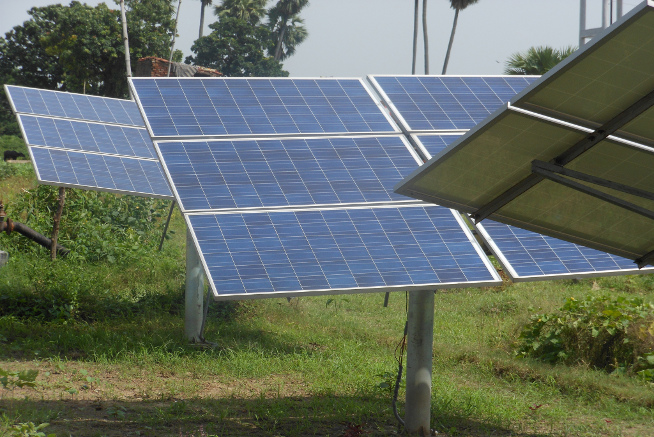Of the 29 states of India, just ten account for 90% of the country’s installed large-scale solar PV capacity and pipeline, new analysis by Mercom Capital Group has found.
As of December 2016, India has 9,018 MW of large-scale solar PV capacity installed, with a pipeline of 14,030 MW, finds the data. Almost all of that capacity, 90%, is to be found in Tamil Nadu, Rajasthan, Gujarat, Andhra Pradesh, Telangana, Madhya Pradesh, Punjab, Karnataka, Maharashtra, and Uttar Pradesh.
Outside of these states there is just 435 MW of large-scale solar installed, and 1,923 MW in the pipeline. Mercom Capital Group finds that the state with the most installed PV capacity is Tamil Nadu, with 1,577 MW of solar in operation and some 485 MW under various stages of development. The state’s Tamil Nadu Generation and Distribution Company (TANGEDCO) recently auctioned an additional 500 MW of solar capacity.
The second-largest solar state in terms of capacity is Rajasthan, which has 1,324 MW installed. However, its PV pipeline is far larger than Tamil Nadu’s, standing at around 1,206 MW, so it could reclaim top spot soon, Mercom forecasts.
Gujarat is the third-most popular state for solar installations, boasting 1,101 MW in operation and 300 MW under development. Mercom says that the state has already met its Renewable Purchase Obligation (RPO) and thus is in no hurry to boost its PV installations any time soon.
Fourth-largest is Andhra Pradesh, which is the state with the most official solar parks and one of the largest pipelines: current installed capacity of 1,009 MW is dwarfed by the 1,494 MW under development. It is a similar situation in Telangana, which has the fifth-largest installed capacity (1,006 MW) but a pipeline of 2,418 MW under development.
Solar’s impact on the state of Madhya Pradesh has been impressive, with PV playing a role in transforming the state from one lacking sufficient power to a power-surplus state. Its 861 MW of solar is the sixth-highest, and a pipeline of 722 MW is solid. Punjab, the seventh-strongest solar state with 569 MW, is also enjoying solar’s influence and will soon bring another 453 MW online.
The eighth-strongest state for solar in India is Karnataka, which has 511 MW installed. However, activity in the state is brisk, and its pipeline of more than 3,370 MW is the largest nationwide. Maharashtra and Uttar Pradesh make up positions nine and ten, with 384 MW and 241 MW installed respectively, while their pipelines are 957 MW (Maharashtra) and 696 MW (Uttar Pradesh).
No plain sailing
Despite these impressive PV gains over 2016, there are a number of challenges facing India’s solar sector, specifically in these ten states that have already shown the most promise. Tamil Nadu and Rajasthan, says Mercom, have grappled with curtailment issues for some time, with DISCOMs in these states infamously wary of purchasing solar energy that costs more than conventional energy. TANGEDCO in particular has a reputation for this, and with Tamil Nadu still yet to sign up to the Ujwal DISCOM Assurance Yojana (UDAY) program that aims to address financial concerns of DISCOMs, the situation could persist for some while yet.
Popular content
DISCOMs in Andhra Pradesh remain cautious, reluctant to spend more than the RPO dictates on solar, which could lead to transmission losses for PV, while in Punjab – which is very agricultural – DISCOMs are again not keen on buying expensive solar power to provide subsidized power to farmers.
Transmission and grid concerns bedevil Telangana, which could store up trouble for developers working on the state’s huge pipeline, while in Madhya Pradesh the ugly specter of payment delays and curtailment is never far from the surface, says Mercom. In Karnataka, DISCOMs have very little capital and thus an inherent aversion to long-term PPAs and the higher purchase costs of solar.
Similar concerns over large-scale solar’s financial viability persist in Maharashtra and Uttar Pradesh, with the prevailing attitude being one of solar “lacking a financial infrastructure in the country that is impeding desired growth”, according to one developer.
To address these challenges, work will begin on transmission and grid upgrades in a number of states in 2017, while policy upheavals are working their way through in other states. “We are trying to fast-track the competitive bidding process and solve issues between DISCOMs and developers,” a Rajasthan Renewable Energy Corporation (RRECL) official told Mercom Capital. This green energy transmission corridor will support DISCOMs in signing PPAs, the RRECL believes.
In Tamil Nadu, TANGEDCO is building a series of substations to aid transmission, and in Madhya Pradesh concerns over evacuation and grid-connectivity are on the verge of being resolved, officials say. “None of the state DISCOMs received notification from higher authorities to connect transmission and grid lines,” said a representative of Madhya Pradesh Urja Vikas Nigam (MPUVNL). “As of now, all details are being distributed to zonal and sub-zonal offices and through interdepartmental deliberations.”
At national level, reports Mercom, the Solar Energy Corporation of India (SECI) stresses that financing channels will be widened and development banks and foreign investors encouraged to pour capital into the market.
“To complement growth in the solar sector the Ministry of New and Renewable Energy (MNRE) has facilitated easy finance through IREDA, initiated pilot projects for R&D, and launched the solar park program,” said an MNRE official.
This content is protected by copyright and may not be reused. If you want to cooperate with us and would like to reuse some of our content, please contact: editors@pv-magazine.com.


It will be good to now the uptake of pv Modules (make & model for each utility scale ) in India for these Farms so that some one can track their performance against guaranteed output and projected life of the installation. This will become a huge O&M cost & reliability issue in the coming years!